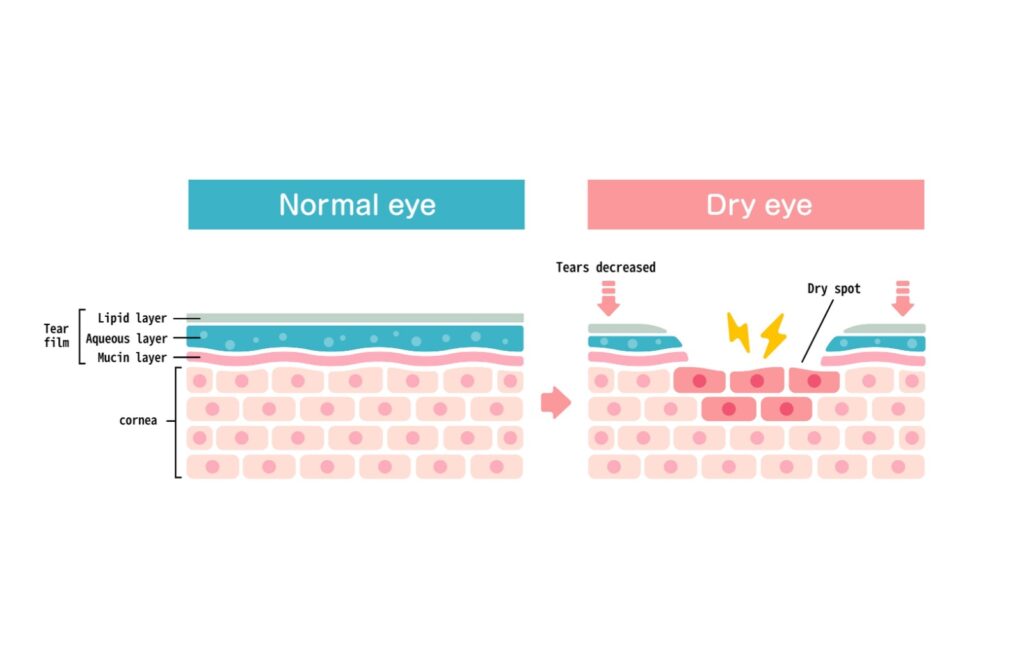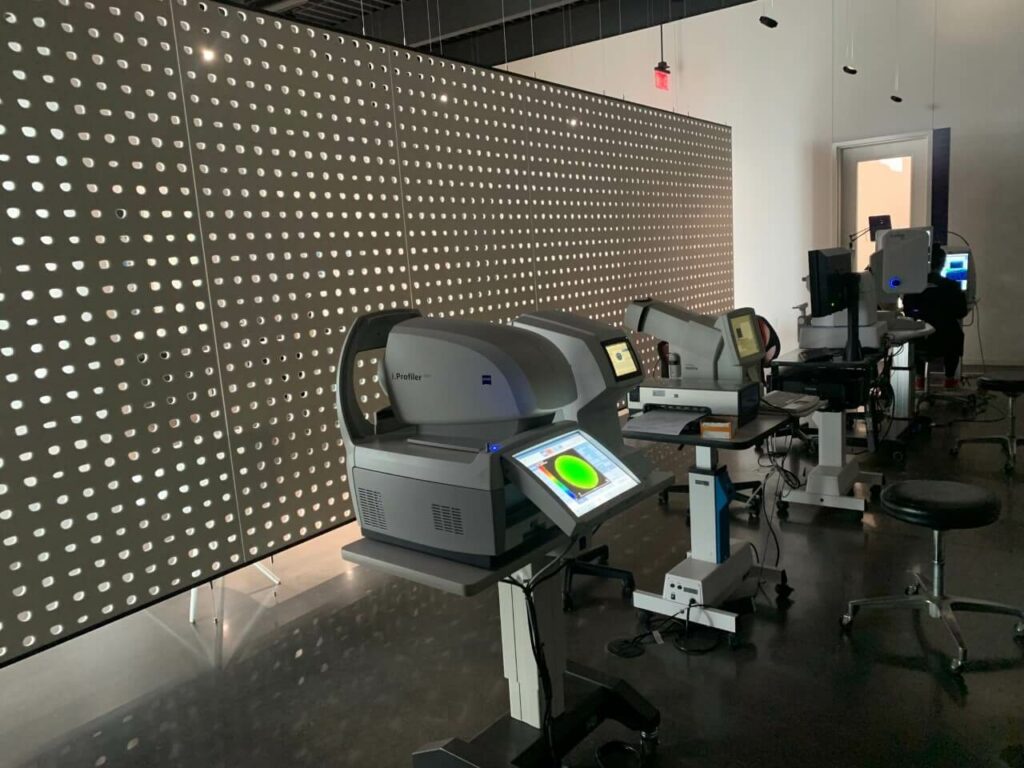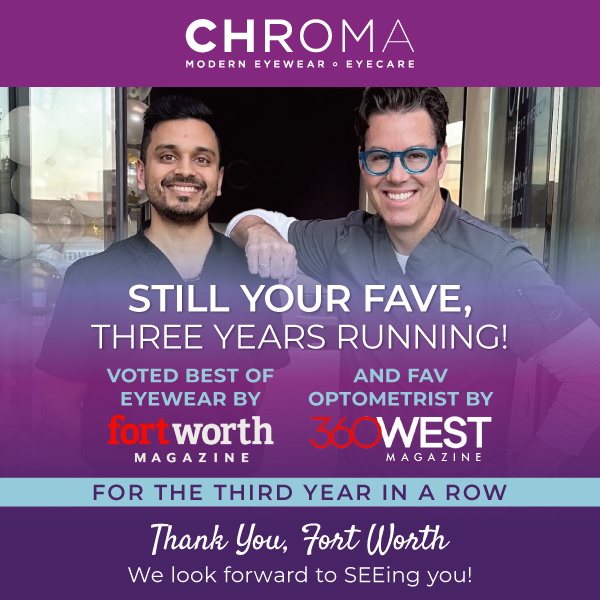When we think of things that threaten our eyesight, we often picture dramatic scenarios—a shard of glass, bright welding arcs, or perhaps a serious eye condition. But one of the most common problems people face is dry eye disease. Recognizable by the burning sensation in the eyes, dry eyes can be extremely uncomfortable—but can they cause blindness?
If it’s left unaddressed for too long, dry eye disease can cause damage to the cornea. This can lead to long-term damage to your vision, though it’s important to note that this is rare. If you frequently experience dry eyes, visit the eye doctors at CHROMA modern Eyewear Eyecare to discuss treatment through dry eye therapy.
What Is Dry Eye Disease?
If you’ve ever felt a dry, burning, and gritty sensation in your eyes, it was probably dry eye. Dry eye is often a chronic condition that leaves the eye vulnerable and exposed, leading to discomfort and burning sensations. It may feel like a piece of sand is trapped under the eyelid.
An issue with your tear development causes this and often brings about symptoms of:
- Burning sensations
- Light sensitivity
- Blurred vision
- Difficulty wearing contact lenses
- Soreness
These symptoms can vary from person to person. While some people may notice mild irritation, others may notice significantly worse symptoms, like overly watery eyes or blurrier vision.
What Causes Dry Eye Disease?
Your tear film is responsible for several tasks. It helps to keep your eye hydrated while protecting it from outside contaminants. If dust, debris, or bacteria enter the eye, the tear film is supposed to flush it out.
This tear film is made up of 3 layers:
- The mucin layer: The inner layer that attaches the tear to the eye’s surface
- The aqueous layer: The middle layer that makes up most of the tear’s structure, which helps flush away contaminants and hydrate the eye.
- The lipid layer: The outer layer that prevents tears from evaporating while keeping the outer surface smooth so light can enter the eye
You have dozens of tiny little glands called the meibomian glands inside your eyelids. These glands produce the oils to keep your tears from evaporating too quickly. However, these glands can sometimes become blocked, clogged, or impacted in some way. This reduces the amount of oil reaching your tear film, potentially leading to early tear evaporation and dry eye symptoms. This is called “meibomian gland dysfunction” and is a leading cause of dry eyes.
Sometimes, your eyes don’t produce enough liquid for the aqueous layer. When this occurs, it’s called “aqueous-deficient dry eye.”
Whether the symptoms are due to an aqueous deficiency or meibomian gland dysfunction, the symptoms are often the same—the eye is vulnerable and unprotected, easily becoming inflamed and irritated.

The Long-Term Effects of Dry Eye Disease
While the irritation and inflammation caused by dry eye disease can be extremely irritating, the problems don’t stop there. The cornea—the clear front tissue at the front of the eye—relies heavily on your tear film to keep it smooth, clear, and functioning.
However, when there’s no moisture, the cornea is unprotected. This makes it significantly easier for the cornea to become damaged in some way. When your tear film no longer protects the eye, your cornea is much more susceptible to:
- Infections
- Scratches
- Inflammation
- Scarring
Over time, this can become much more problematic. If the cornea is scratched or damaged in some way, it develops scar tissue. This begins to impact how light can enter the eye, and if left unaddressed for too long, it can lead to long-term vision problems or even blindness.
This is why it’s essential to visit the eye doctors at CHROMA to discuss treatment options. It’s about more than just finding relief—it’s about preserving your vision in the long run to prevent significant vision problems.
Is Dry Eye Treatable?
Luckily, dry eye therapy can be an excellent approach to preventing these problems. It has a dual purpose—it helps prevent long-term vision damage and helps you find relief from your dry eye symptoms. If you suffer from chronic dry eye, it’s essential to visit the eye doctors at CHROMA.
When you come to visit our team to discuss dry eye therapy, we’ll likely recommend the following:
- Making environmental changes, such as using a humidifier
- Taking supplements to encourage healthy tear production
- Over-the-counter or prescription eye drops to find temporary relief
However, it can help to address the underlying cause of your dry eyes to improve how your tear film functions. At CHROMA, we can advise:
- Amniotic membrane treatment: Where stem cell tissues are used to encourage healing and regeneration in the eye
- Autologous serum drops: These are drops in which sterile tears are created using your blood plasma and help replenish the eyes using your body’s natural properties
- Punctal plugs: These are minuscule plugs inserted into the tear ducts to prevent fluids from draining too quickly
This way, we can help your eyes create the tears they need to protect the cornea properly.
Can an Optometrist Help with Dry Eyes?
If you’re experiencing dry eyes, talk to the eye doctors at CHROMA modern Eyewear Eyecare. Our team can determine what’s causing your symptoms and recommend an appropriate treatment. Don’t let dry eyes drag you down—book an appointment today.



